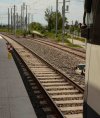I just read an article in the last edition of the French railways magazine "rail passion", explaining that French railways are currently testing a new signaling system that will allow two trains to share the same track in stations, as a way to increase the capacity of heavily congested stations without having to add new tracks.
I'm a bit surprised to read that a special signaling system is needed for that. As far as I remember, this has been standard practice in Belgium with no special devices needed, other than an entry signal that can display the "admission on occupied track" aspect.
What is the situation in other countries ? Is it done on a regular basis and, if yes, are there special signals or devices deployed for that purpose?
I'm a bit surprised to read that a special signaling system is needed for that. As far as I remember, this has been standard practice in Belgium with no special devices needed, other than an entry signal that can display the "admission on occupied track" aspect.
What is the situation in other countries ? Is it done on a regular basis and, if yes, are there special signals or devices deployed for that purpose?


